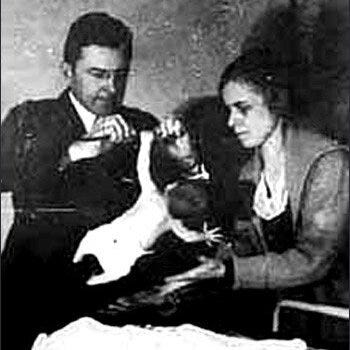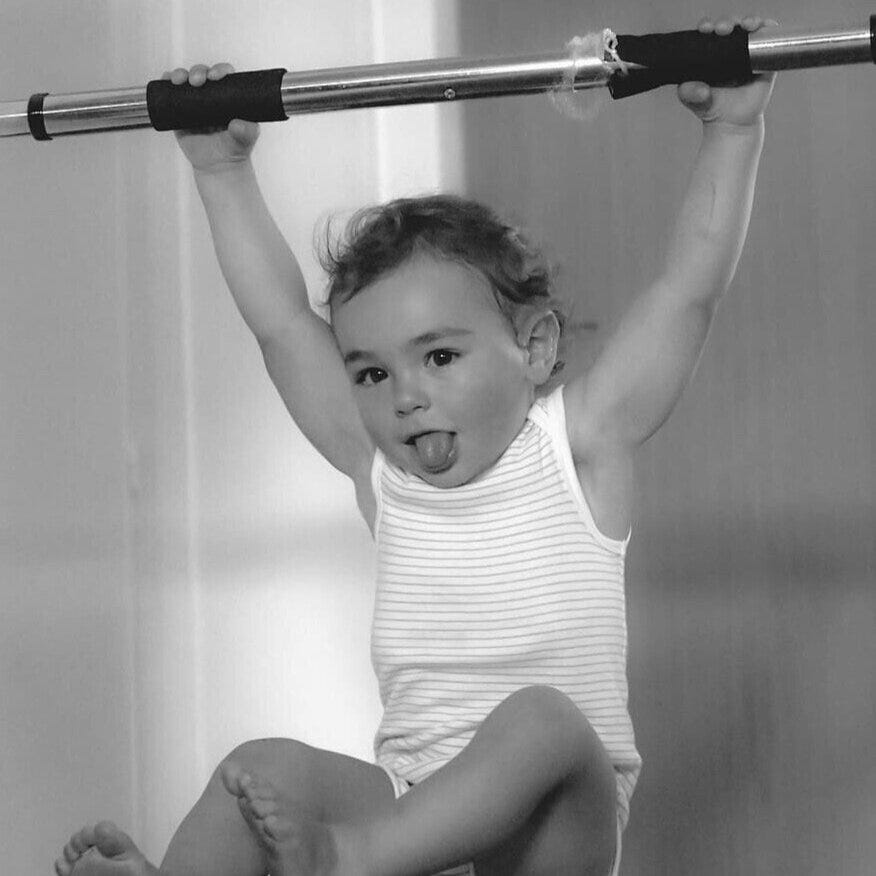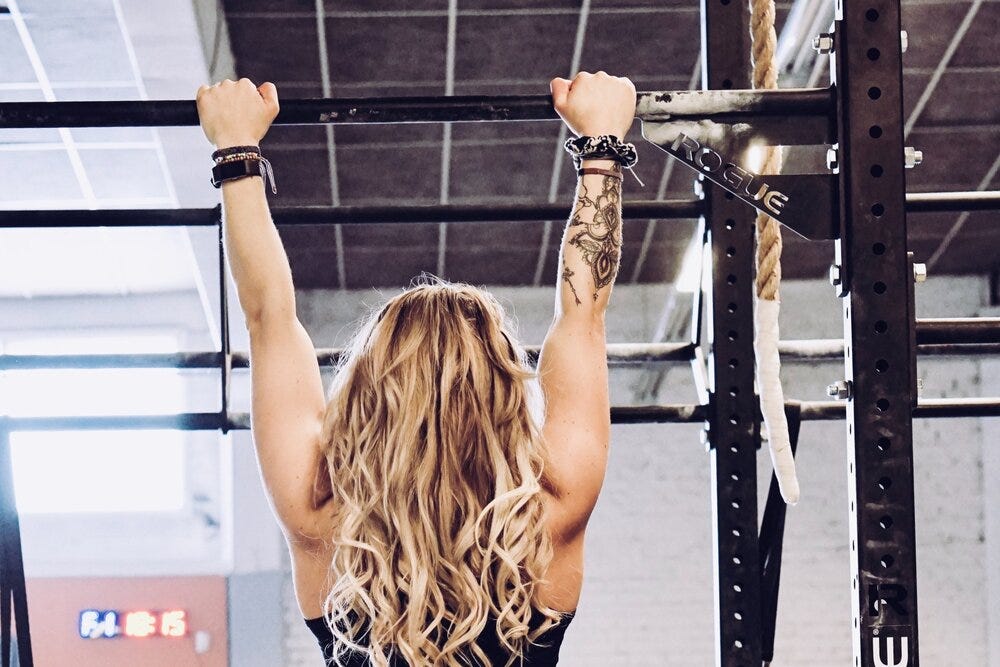If I had to pick one physical activity that is healthy for human beings, and which they don’t do very much, it would be hanging. Shoulders are built for hanging and swinging, but these actions are rarely included in exercise programs. Pull-ups offer similar benefits, but they aren’t as natural, simple, and easily tolerated.
Our distant ancestors lived in trees for millions of years, so they grabbed onto lots of branches. The best way to get around in trees is brachiation, which means swinging from branch to branch with long arms. Gibbons can brachiate at speeds up to 35 miles per hour, which is faster than Usain Bolt can run. Human ancestors descended from the trees long ago, but we retain many of the anatomical characteristics that evolved for brachiation, such as hugely flexible shoulders, long arms, rotating wrists, and clasping hands.
The naturalness of hanging and swinging is easily seen by watching young children, who start doing these movements spontaneously.
If there is a bar within reach, they will start hanging from it, usually with the knees moved up into a position that aligns and stabilizes the trunk. Swinging comes next, which they do by pumping the feet back and forth. If kids play near a set of monkey bars, most will eventually learn to swing hand to hand, without any coaching. You won’t see them busting out a set of pull-ups unless they are involved in competition or formal practice. But hanging and swinging are as natural as running around.
Many movement coaches, trainers, and even surgeons speculate that hanging from a bar is great for shoulder health, and even a cure for shoulder pain. The proposed mechanism is creating space in the joint to avoid compression or impingement of sensitive tissues.
I have not seen quality evidence to support these claims, but I do know from personal experience that hanging from a bar feels really good. I hang for at least a minute every day, and almost anytime I see a bar within reach. It makes me feel loose, strong, and ready to move, and I know many people who say the same thing. I don’t think I have heard anyone say that hanging makes them feel worse. Therefore, hanging is on my short list of “stuff worth trying” if you want your shoulders to move better and feel better.
Here are some ideas about how to play with hanging and swinging. For best results, make sure to spend plenty of time exploring and getting comfortable with the easy moves before moving onto the more challenging ones. And if it doesn’t feel good, don’t do it!
Lighten your weight
Unless you have excellent grip strength and overall fitness, most of the movements described below will be easier and more productive if you find some way to reduce your effective bodyweight. This means having the feet take some of the load (if the bar is too high use use a stool or chair.)
Mess with hand position
Experiment with different hand positions to find the one where you feel most comfortable and strong. For most people that will be the palms forward and hands shoulder width apart. You can experiment with thumb position too - try thumb with the fingers monkey-style.
Play with scapular movement
Now that you are hanging, notice the work of the muscles that control the scapula. Are they passive, so the shoulders come up to the ears? Or more active, keeping the shoulders lower? Slowly move back and forth between these two positions, keeping the elbows straight, so you can feel the difference between active and passive shoulders while hanging. Don’t think of either position as right or wrong - they are just different ways to hang, and you should be comfortable with both. Which option would allow you to hang longer? Probably the released shoulders, because that is less work.
Release tension
Now let the shoulders be passive, and try to release muscle tension, so your body gets as “long” as possible. Let the spine and tailbone sink down to the floor, so that every space between the ribs and vertebrae expands. Find spaces that are holding tension, and see if they can let go.
If you are interested in the slings or “trains” of myofascia that connect distant bones, this is an easy way to get a felt sense for where they are and what they do. Feel the chains of tension that connect the hands to the shoulder, and the shoulder to the pelvis, especially where they move through the armpit. Do you feel the lines of pull more clearly through the front (the pecs and abs)? Or the back (the lats and back muscles)?. Take a break from hanging, walk away and see if your can feel the effects on your shoulder mobility, posture and breathing.
Play with subtle movements
You can vary where you feel the stretch by making slight adjustments to the positions of the feet, knees, pelvis, or head. For example, as you hang, slowly move the knees upward, so the hips and knees come into a chair sitting position. This will encourage the pelvis to move into a posterior tilt, and the spine to flex slightly. To make the pattern more clear, look down with the head toward the pubic bone. What effect does this have on where you feel the stretch of hanging? What chains of muscle are now providing more support?
Now do the opposite movement - let the feet and knees move slightly behind you, encouraging the spine to come into extension. Let the head come back and look upwards to make the pattern more clear. Note again the effects on your sense of connection from shoulders to pelvis. Now move slowly back and forth between the two positions, so you can feel the difference. You could also explore moving the knees and feet slightly left and right to feel the effect of subtle rotations or lateral flexions. Which hand feels more pressure if the feet move left? Which armpit feels more stretch?
You can use these movements to explore the mobility and integration of almost every muscle in the trunk. Walk and away and see if you can feel the effects.
Swing
For a more dynamic version of the above movements, move the feet and knees back and forth more quickly, and with rhythm, so that you start to swing a little. Try it with the knees bent versus long and compare. If this is feeling easy, you can play with a jump dismount from the forward swing. Or jumping forward to the bar to initiate the first swing. You can also swing side to side.
Reach with the feet
While hanging from the bar, pick a target and reach with a foot to touch it. Imagine you are hanging from a branch and need to find the next foothold. Use some momentum from swinging if you want.
Hang for time
Playing with all the above movements is a surprisingly good challenge to strength. I stopped doing pull-ups for a few months in favor of just playing around with hanging and swinging, and then did a pull-up test and hit 17 (which for me is better than usual.)
Here’s a way to test your endurance. See how long you can just hang with your full bodyweight. Or hang for 30 seconds, try a pull-up, then 30 more seconds of hanging, and another pull-up. This progression is recommended by strength coach Dan John, who says five is a respectable number.
One-arm variations
You can perform similar versions all of the above movements with one arm. And more. With one arm free, you are now free to reach for targets or imaginary branches with the free hand. Notice the rotation that happens in the hanging shoulder. Explore reaching forward and back, as if you are reaching to monkey bars. Make sure to use lots of support from the feet to stay safe. If you are feeling comfortable with all the above movements, and you are confident in your strength, mobility and coordination, you are ready for the final test: find some monkey bars at a playground, and try to get across as fast as a third-grader.






